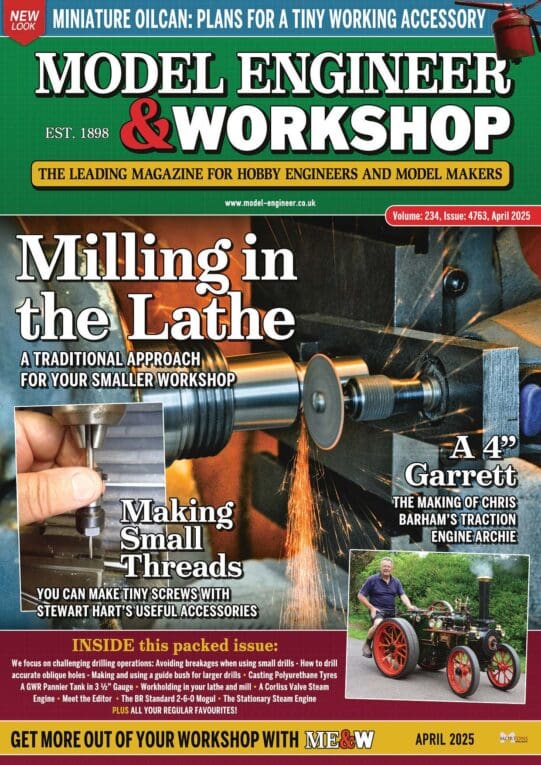John – I recommend Greenwood too. I think they supply tools with Sandvik tips. Seco tips are very good too. I think the tips supplied by Chronos are mostly Seco, though I don’t know about their parting tips. Howver the CCMT -06 tips are. (Greenwoods Kit Q cut parting thing is super – that uses the Sandvik T-MAX Q cut tip N151-250 -5E. There is a 5F tip which I prefer – better finish for a lower feed rate. There are also right and left handed ones to drop the cut off bit, pip free (the designation is N151r/l xxxx etc) thats a 2.5mm seat.
Dave, pretty well all tipped tools will seem blunt – – The full designation for the positive rake lozenge shaped tips is a CCMT -06 (cutting length) – 04/08. Nose radius in mm. Most of ours are.4mm radius though the .8 mm are very good for roughing, or producing a good finish. However you do need to bevel whatever is to fit over it..
Your final cut, in crude terms, should not be much less than the nose radius, or as John has said, it will tend to skid – that is the recomendation. However, that normally leads to faulty dimension, and not usually poor finsh. With good tips I regulary take cuts of a thou or so against the recomendation and it works fine – but I am pretty confident that the headstock bearings in both lates are 100%. However, I’ve never yet been able to skim say 1/4thou with a tip, which I can with ground HSS. (theSuper 7 has a 3″ scale graduated in 1/2 thou)
Finish – you can overdrive them. The Sandvik recommendation (for a CCMT 06 for normal finish), is a feed rate of .1-.4mm per rev. The SECO is rather better. But you’ll know because it goes rather graunchy. The chip stops being “nice” and the finish can go. If you are hand feeding you’ll feel it instantly. As the tip gets older abrasion affects it, and the finish goes, so does that apply?.
i have a suspicion you may have found a slackness in your lathe. Assuming the tool is at centre height, and the top slide gibs are properly adjusted (or the top slide is locked during the cut) and feeds and speeds are correct, and the coolant is good, I’d look at the back of the saddle – the gib there.
I had exactly the same problem with a new 6″ x37″ lathe – actually with both ground and tipped tools. Finish and to a lesser degree dimension went to pot after about 3 months. I think the packing grease, which went hard, and probably wasn’t really 100% cleaned off from new under the back of the bed, and within the gib blocks themselves, started to wear out or be squeezed out – anyway, outed one way or another. Another symptom was mild chatter on parting off, until you took a decent deep cut, when the chatter would go.
What was happening was this. Load the tool, and the saddle tilts slightly as the tool bites. As it lifts, the cut reduces fractionally, so the saddle drops, increasing the cut, so the saddle lifts… and so on. All on a small scale of course. Anyway, checked all adjustments, cleaned off the rear gibs with white spirit, and under the rear bed where the gibs bear. Readjusted till I could just detect a drag with a set of spring scales (old fshing ones)and problem gone, and has stayed gone.
As for using tipped tools – well they are only a convenience, if you don’t have a proper tool and cutter grinder. You wont take a cut of 250 thou, which is 1/2″ on diameter on a Super 7 with a tipped tool in free cutting mild. (CCMT06), which you can with a properly ground up high speed tool. With the late set at 600 rpm it does it on a hand feed without even blinking – reasonably slack belts too! I tend to use them for roughing and cast iron, and grind everything else up on a Quorn.
Industry uses them of course because of repeatability, high cutting speeds and because relatively its cheaper to change a tip than to have to get all reground and reset. But for us, I think the convenience comes pretty expensive.
Lastly cutting speeds – about 600rpm for anything steel or so it seems!!!!
3.8 x cutting speed in FPM/job dia in inches. = revs. also applies to milling, but substitute cutter dia for job dia.
Cutting speed in mild – I always cut at 100FPM, because Tubal Cain (TD Walshaw) said so somewhere and Tubal Cain was never wrong. And it works well – tipped or conventional tools.
Edited By meyrick griffith-jones on 14/06/2009 23:46:17
Dave Harris.






